Organization
Consisting of a headquarters platoon, communications platoon, and three LRS platoons (each made up of a headquarters section and six surveillance teams.) All non-commissioned officers are airborne and Ranger qualified. All other personnel in the company are Pre-Ranger and airborne qualified. All Company Personnel undergo a week-long assessment and selection in addition to psychological evaluation. There are two types of selection, LRS selection and LRS Support personnel selection. Although all LRS team members can infiltrate via Land, Sea or Air; each platoon specializes in one method of infiltration. Each platoon is broken down into one of three infiltration specialties; Water, High Altitude Low Opening (HALO) and Desert Mountain.

A non-commissioned officer (NCO) is a military officer who has not earned a commission. Non-commissioned officers usually obtain their position of authority by promotion through the enlisted ranks. In contrast, commissioned officers hold higher ranks than NCOs, have more legal responsibilities, are paid more, and often have more non-military training such as a university diploma. Commissioned officers usually earn their commissions without having risen through the enlisted ranks.

The United States Army Airborne School – widely known as Jump School – conducts the basic paratrooper training for the United States armed forces. It is operated by the 1st Battalion (Airborne), 507th Infantry, United States Army Infantry School, Fort Benning, Georgia. The Airborne School conducts the Basic Airborne Course, which is open to troops of both genders from all branches of the United States Department of Defense, Reserve Officer Training Corps, and allied military personnel. All students must volunteer to attend the course.

The United States Army Ranger School is a 61-day combat leadership course oriented toward small-unit tactics. It is open to Soldiers, Sailors, Airmen, and Marines in the U.S. Armed Forces, as well as select allied military students.
A. Headquarters platoon. The headquarters platoon contains two sections for the command and control of the company in the areas of administration, logistics, and operations.
- (1) Headquarters section. This section contains the personnel necessary for the command and control of the company and supply support.
- (2) Operations section. The personnel in this section plan and control the employment of the teams, coordinate insertion and extraction of the teams to include external support, receive and report information from committed teams, and maintain the operational status of all teams. Liaison duties and planning for future operations are important functions of the operations section.
B. Communications platoon. The communications platoon operates the base radio stations. It helps the operations section plan and maintain communication with deployed teams. It works with the operations section or separately to relay information from deployed teams. It also performs unit maintenance on communication equipment organic to the unit. The platoon has a headquarters section and four base radio stations.
- (1) Headquarters section. The personnel in this section establish command and control over assigned communications elements. They coordinate and set up communication procedures, transmission schedules, frequency allocation, and communication sites. They issue and control encryption code devices and materials. They ensure continuous communication between deployed teams and base radio stations. They provide communication support to detached LRS platoons. They augment division Long Range Surveillance Detachment's (LRS-D's) with communication support when directed. They also provide unit maintenance for company communication equipment.
- (2) Base radio stations. The four base radio stations maintain communication between the operations base and the deployed teams. They operate on a 24-hour basis to make sure all message traffic to and from teams is processed immediately.
C. Long-range surveillance platoons. These three platoons contain a headquarters element and six surveillance teams each.
- (1) Headquarters section. This section contains the personnel necessary for command, control, and training of the platoon.
- (2) Surveillance teams. (LRS Team) Each team consists of a team leader, an assistant team leader, Senior Scout, scout observer, a RTO (Radio Telephone Operator) and an assistant RTO. The teams obtain and report information about enemy forces within the corps' area of interest. LRS teams also conduct Combat Search And Rescue missions. The teams can operate independently with little or no external support in all environments. Each team member is cross trained in the duties and responsibilities of the others. Every team member is responsible for at least two duties and responsibilities. LRS teams are often seen as the most elite infantryman. They are lightly armed with limited self-defense capabilities. To be easily transportable, they are equipped with lightweight, man-portable equipment. They are limited by the amount of weight that they can carry or cache. Because all team members are airborne qualified, all means of insertion are available to the commander when planning operations.

A battalion is a military unit. The use of the term "battalion" varies by nationality and branch of service. Typically a battalion consists of 300 to 800 soldiers and is divided into a number of companies. A battalion is typically commanded by a lieutenant colonel. In some countries, the word "battalion" is associated with the infantry.

Marine expeditionary units are the smallest air-ground task forces (MAGTF) in the United States Fleet Marine Force. Each MEU is an expeditionary quick reaction force, deployed and ready for immediate response to any crisis, whether it be natural disaster or combat missions. Marine amphibious unit (MAU) was the name used until the late 1980s.
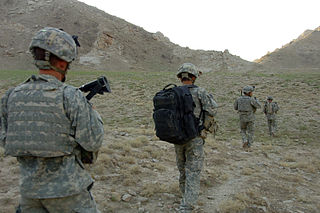
Long-range surveillance (LRS) are elite, specially-trained surveillance units of the United States Army employed for clandestine operation by Military Intelligence for gathering direct human intelligence information deep within enemy territory. Classic LRS employment is to infiltrate deep into enemy territory, construct hide and surveillance sites, and provide continuous surveillance/special reconnaissance of an intelligence target of key interest.
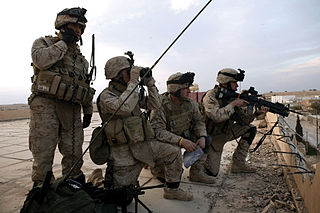
Air Naval Gunfire Liaison Companies (ANGLICO) are airborne fire support and liaison units of the United States Marine Corps. The mission of ANGLICO is "To provide Marine Air-Ground Task Force (MAGTF) Commanders a liaison capability to plan, coordinate, and conduct terminal control of fires in support of joint, allied, and coalition forces." Per this mission statement, ANGLICOs are not designed to support U.S. Marine Corps maneuver elements. Instead, the doctrinal purpose of ANGLICO is to provide fire support and coordination in support of units adjacent to the MAGTF.
Reconnaissance, surveillance, and target acquisition (RSTA), is a type of unit in the United States Army. RSTA units are small reconnaissance units based on cavalry squadrons, and act at the squadron (battalion) level as a brigade reconnaissance team for the regiment (brigade).

United States Army Reconnaissance and Surveillance Leaders Course (RSLC) is a 29-day school designed on mastering reconnaissance fundamentals of officers and non-commissioned officers eligible for assignments to those units whose primary mission is to conduct reconnaissance and surveillance, target acquisition, and combat assessment operations. RSLC is taught by Delta Company, 3rd Squadron of the 16th Cavalry Regiment, 316th Cavalry Brigade. The school is open to Soldiers, Marines, Sailors and Airmen to train them to expert levels in reconnaissance, surveillance, target acquisition, battle damage assessment, communications, planning, foreign vehicle identification, and other skills. The school was originally created to serve leaders from Long Range Surveillance Units (LRSU's), but now provides the specific reconnaissance training needed to ensure the effectiveness of small unit reconnaissance elements for the U.S. Army and joint force. Given the training focus and difficulty of the RSLC, the school is still commonly attended by operators from U.S. Army Special Forces, the 75th Ranger Regiment's Regimental Reconnaissance Company, Navy SEALs, and Marine reconnaissance units; today students are primarily soldiers from conventional infantry, Stryker and armored Brigade Combat Teams (BCT). Following the US Army decision to disband US Army LRS companies, the reconnaissance fundamentals taught in the course also provides U.S. military commanders the ability to preserve key LRS skills and abilities within the conventional force.
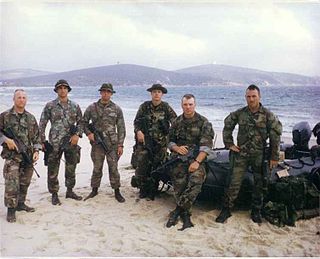
The Radio Reconnaissance Platoon is a specially trained element of a United States Marine Corps Radio Battalion. A Radio Reconnaissance Team (RRT) was assigned as the tactical signals intelligence collection element for the Marine Corps Special Operations Command, Detachment One. Regular RRTs also participate in SOC operations during Marine Expeditionary Unit, or MEU(SOC), deployments.
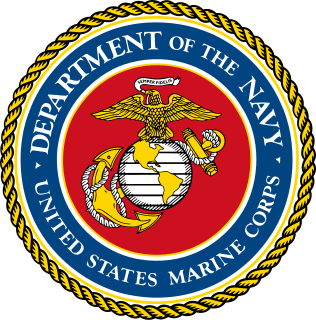
The United States Marine Corps is organized within the Department of the Navy, which is led by the Secretary of the Navy (SECNAV). The most senior Marine commissioned officer is the Commandant of the Marine Corps, responsible for organizing, recruiting, training, and equipping the Marine Corps so that it is ready for operation under the command of the unified combatant commanders. The Marine Corps is organized into four principal subdivisions: Headquarters Marine Corps, the Operating Forces, the Supporting Establishment, and the Marine Forces Reserve.
The United States Army long range surveillance detachment (LRSD) is organized as a detachment organic to the military intelligence battalion at division level for the purpose of long-range surveillance. The LRSD's are organized into a headquarters section, communications section, and six surveillance teams. The leaders are airborne and Ranger qualified. All other personnel in the detachment are airborne qualified. Most active Army LRSDs were inactivated in September 2005, with the notable exceptions 173rd Airborne's LRSD which was deactivated in 2006 and the 82nd Airborne's LRSD, which was converted to Pathfinders in 2008, and most Army National Guard units were inactivated in September 2008; some were transferred to battlefield surveillance brigades and were reflagged and redesignated as Troop C within the brigade's cavalry squadron. For example, the 151st Infantry Detachment (LRS) of the 38th Infantry Division became Troop C (LRS), 2d Squadron, 152d Cavalry Regiment, 219th Battlefield Surveillance Brigade. Two new National Guard Long Range Surveillance Companies were stood up in September 2009.
In the United States Marine Corps, the ground combat element (GCE) is the land force of a Marine Air-Ground Task Force (MAGTF). It provides power projection and force for the MAGTF.

Company F, 425th Infantry was a long range surveillance unit of the Michigan National Guard that was inactivated on 12 June 2011. The company came into being in the mid-1960s when the 1st Battalion (Airborne), 225th Infantry was reflagged as Companies E and F (Ranger), 425th Infantry, and organized as Ranger companies. During this period these two companies were assigned to division and higher level commands to perform long range reconnaissance patrol missions, as opposed to the Ranger companies of today which comprise the four battalions of the 75th Ranger Regiment. According to the United States Army Center of Military History, it was reorganized and redesignated as the 425th Infantry Detachment (LRS) effective 1 September 2008 and was relocated from the State of Michigan Pontiac Armory to the Selfridge Air National Guard Base near Mount Clemens, 15 miles northeast of Detroit.
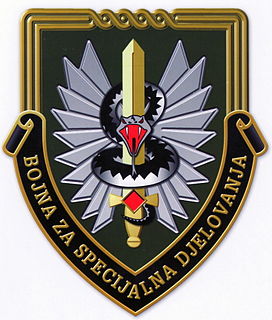
The Special Operations Battalion, or popularly BSD was founded on 8 September 2000 when the Special Combat Skills Center from Šepurine and the 1st Croatian Guards Brigade were amalgamated. It ceased to exist in 2014, when it was transformed into Special Operations Command (Croatia)

The 140th Military Intelligence Battalion of the United States Army Reserve was constituted on 16 July 1986, assigned to the 63rd Army Reserve Command, and activated with headquarters at the General George Smith Patton, Jr. United States Army Reserve Center, located at 5340 Bandini Boulevard in Bell, California. The battalion inactivated in 1995.
The Reconnaissance & Surveillance Squadron is a specialized unit within the US Army's new Battlefield Surveillance Brigade (BfSB) that blends ground Cavalry troops with an Elite Long Range Surveillance (LRS) Airborne Infantry Company continuing the [US Army]'s march toward a modular force.

The 71st Expeditionary Military Intelligence Brigade is a unit of the Texas Army National Guard.

The 525th Expeditionary Military Intelligence Brigade (Expeditionary) is a unit of the United States Army specializing in the acquisition and analysis of information with potential military value. On 28 October 2014, the unit was reflagged from the "525th Battlefield Surveillance Brigade" to an expeditionary military intelligence brigade, the first of its kind.
The communications platoon, also known as the "S-6" is responsible for all related communications for the battalion. It is part of the Headquarters and Services Company and is responsible for supporting all companies within the battalion. At the regiment level, the communications platoon is responsible for providing support to the regiment as well as the battalion communication platoons. Within the communications platoon, there are four sections: Data, Wire, Radio, and Maintenance. Each of these sections have specialized individuals who have been trained to best understand their field.
















